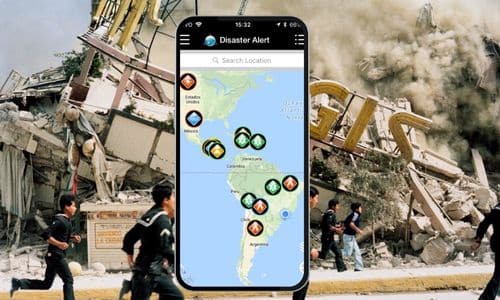Overview of the Earthquake Detection Mobile App
An overview of the earthquake detection mobile app is essential to understanding how it works and how users can benefit from its features. The app provides an interactive experience where users can visually monitor seismic activity in their local area.
It allows users to track earthquakes around the world, with a detailed list of events for each location. Users also have access to a variety of tools, such as earthquake alerts and notifications, allowing them to stay informed about potential disasters in their neighborhood.
In addition, maps are provided so that people can quickly identify which areas are affected by earthquakes and take appropriate action if necessary. In addition, the app includes educational resources on seismology, providing useful information on types of earthquakes and safety guidelines for those who live in seismic areas.
With all these features combined, this mobile app helps ensure that people are aware of seismic activity around them and prepare accordingly when necessary.
Earthquake Detection Mobile Application: Sensors and Algorithms
The sensors used in mobile apps earthquake detection are seismometers and accelerometers. Seismometers measure ground vibrations caused by an earthquake, while accelerometers detect sudden changes in acceleration.
The data from these sensors is analyzed by algorithms to determine the strength of the earthquake and its location. The algorithms use both frequency domain analysis, which measures how fast the ground shakes, and time domain analysis, which analyzes how long it takes for an earthquake to reach its maximum intensity.
This allows them to accurately detect even small or distant earthquakes accurately enough that they can be reported in real time on mobile devices.
Additionally, algorithms can be used to filter out false alerts due to other causes, such as industrial machines or electrical storms.
The combination of sensors and algorithms provides a powerful tool to detect earthquakes with more precision than ever before, allowing users to react quickly when an earthquake occurs and potentially save lives.
Additionally, advances in sensor technology mean that more accurate readings can be taken over much wider areas than was previously possible with traditional seismic monitoring techniques.
This could lead to better preparedness when large earthquakes occur by allowing emergency services personnel to gain a better understanding of where help is most urgently needed after a tremor event.
User interface: user friendly design
User-friendly design is essential for any user interface, especially when it comes to an earthquake detection mobile app. The objective of this type of applications is to provide users with timely information about seismic activity and possible earthquakes.
Therefore, the design must be intuitive, user-friendly and efficient to ensure that the application can be used quickly and accurately in times of emergency.
This means that the interface should have a clear structure and labels, as well as prominent buttons so that users can easily access features without having to navigate menus or search for settings.
In addition, images and tutorials should also be included to educate users on how to use the app correctly and optimize their experience.
By utilizing a user-friendly design, earthquake detection apps will provide users with the vital information they need during an emergency situation without adding unnecessary complexity or confusion.
Earthquake Detection Mobile Application: real-time monitoring
Real-time earthquake monitoring is a critical component of any mobile earthquake detection app. Access to real-time data allows the app to provide users with more accurate and up-to-date information about seismic activity in their area, as well as giving them the opportunity to prepare for potential disasters.
The most reliable sources of real-time monitoring are seismometers installed around the world. These devices detect seismic waves traveling through the Earth's crust and capture the magnitude, location, and time of occurrence of each event. This data can be accessed through open APIs or purchased from commercial providers who have access to a greater variety of sensors than public networks.
In addition, satellite imagery can also be used to monitor earthquakes in areas where ground-based instruments are not available, although they tend to produce less reliable data due to various factors, such as cloudiness and atmospheric conditions. Finally, social media platforms like Twitter can serve as an additional source of data by providing reports of people experiencing earthquakes in their vicinity.
Accuracy: test and validation
The accuracy of the tests and validations is essential for any mobile earthquake detection application (EDMA) to be reliable. You must be able to correctly identify earthquakes, as well as accurately differentiate between an earthquake and a false alarm. To ensure such accuracy, EDMAs must undergo rigorous testing before being released to the public.
Typically, this involves creating simulations of different types of earthquakes or other environmental events to test how the app responds in each situation. In addition, the app must also undergo validation tests using real-world data from past events to compare with the result of the Earthquake Detection Mobile App.
This helps ensure that you can properly distinguish between true seismic activity and non-earthquake sources of vibration. The results of these tests are then used to tune the parameters within EDMA so that it can provide accurate predictions when deployed in an operational environment.

Benefits: Alerts, Maps and Resources
Alerts: The earthquake detection mobile app provides users with real-time notifications about potential seismic activity. Users can set their own alert settings and customize how often they receive updates. This allows them to stay informed of the latest earthquake news in their area and to be better prepared for any possible seismic activity.
Maps: With the Earthquake Detection Mobile App, users can access interactive maps that show detailed information about seismic activity in a particular area. These maps help users identify high-risk areas for future earthquakes, and also provide visualizations of past earthquakes so people can understand how different types of tectonic activity may affect their region or country.
Resources: In addition to alerts and maps, the earthquake detection mobile app provides access to a variety of earthquake safety-related resources, such as emergency response plans, evacuation routes, and educational materials. By having this information at their fingertips, users are better equipped to respond quickly and appropriately during an earthquake.
Challenges: cost and reliability
Cost and reliability are two major challenges when it comes to mobile earthquake detection apps. The cost of developing such an app is high, as it requires a significant amount of research and development to ensure accuracy. In addition, the cost of providing ongoing support for the application must also be considered.
Reliability is also a concern, as users must trust that the app will accurately detect earthquakes in order for them to use it effectively. To ensure accuracy and reliability, rigorous testing must be done before the app is released and regular updates must be made to keep up with changing seismic activity around the world.
Additionally, developers should pay attention to using trusted data sources and employ advanced algorithms such as artificial intelligence (AI) or machine learning (ML) techniques to improve accuracy levels.
Finally, user feedback should also be carefully considered to identify any potential issues that may arise while using the app.
Conclusion: Earthquake Detection Mobile App
Enhanced security for an earthquake detection mobile app is of paramount importance. The application must be equipped with advanced encryption, authentication and authorization measures to protect communication between users and the server, as well as to prevent unauthorized access.
This ensures that only authorized individuals can access data sent through the app and that all messages are transmitted securely over a secure network connection.
Additionally, strong password protection must be implemented to ensure that all user data is kept safe from malicious attempts to gain access.
Both internal and external staff should also perform regular security audits to ensure potential vulnerabilities are identified early on and addressed in a timely manner.
Software updates should be released regularly with bug fixes that ensure that the system stays up to date with current security threats.
In addition, two-factor authentication processes, such as email/text verification at login, can add an extra layer of security for user accounts in case suspicious activity or unauthorized attempts to gain access are detected.
keep following Digipremiere.com and have the best news in the palm of your hand.


